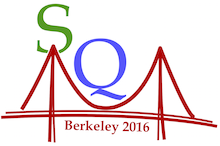Speaker
Andreas Zacchi
(Goethe university, Frankfurt - Germany)
Description
One of the most challenging problems of theoretical physics concerns the structure of the QCD phase diagram and
a possible critical endpoint. Experimental programs with heavy-ion collisions at ultrarelativistic energies and lattice QCD at finite temperature are performed such as to identify position and character of the transition from a hadronic gas to a quark-gluon plasma. Both, HIC experiments and lattice QCD, regrettably cannot address the QCD phase diagram at small temperatures and proportionately large chemical potential where the QCD phase transition is of first order so that a critical endpoint would result.
A guidance for progress in the area comes from astrophysics of compact objects, namely from the mass and radius measurements of pulsars, eventually constraining the equation of state consulted. Among the equations of state obtained via effective models, we find the simple MIT bag model or the more sophisticated chiral Quark-Meson model, respecting several important properties of QCD.
However, the inner regions of one of the most massive compact stellar objects might be occupied by a deconfined phase of quarks. A scenario for a star with deconfined matter is a hybrid star, i.e. a compact object with an outer layer composed of nuclear matter and with a core consisting of quark matter.
We present solutions for stable hybrid stars $\sim 2M_{\odot}$ obtained with a density dependend nuclear matter equation of state for the outer crust, and a chiral three-flavoured quark matter equation of state for the star's core. Furthermore we explore the parameter space for possible twin stars, i.e. star configurations with the same mass but different radii emerging from one equation of state.
The effects of the variable parameters give intriguing insight not only to the mass-radius relation of compact stars, but also on important properties of the corresponding equation of state, the phase transition and the speed of sound within the medium.
Primary author
Andreas Zacchi
(Goethe university, Frankfurt - Germany)
Co-authors
Dr
Juergen Schaffner-Bielich
(Goethe university, Frankfurt - Germany)
Dr
Matthias Hanauske
(Goethe university, Frankfurt - Germany)




